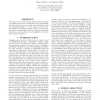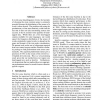44 search results - page 1 / 9 » Two Web-Based Approaches for Noun Sense Disambiguation |
CICLING
2005
Springer
13 years 10 months ago
2005
Springer
The problem of the resolution of the lexical ambiguity, which is commonly referred as Word Sense Disambiguation (WSD), seems to be stuck because of the knowledge acquisition bottle...
ACL
2003
13 years 5 months ago
2003
A central problem of word sense disambiguation (WSD) is the lack of manually sense-tagged data required for supervised learning. In this paper, we evaluate an approach to automati...
SIGIR
2005
ACM
13 years 10 months ago
2005
ACM
This paper presents an algorithm for unsupervised noun sense induction, based on clustering of Web search results. The algorithm does not utilize labeled training instances or any...
NAACL
1994
13 years 5 months ago
1994
This paper presents and evaluates models created according to a schema that provides a description of the joint distribution of the values of sense tags and contextual features th...
ACL
2004
13 years 5 months ago
2004
In word sense disambiguation (WSD), the heuristic of choosing the most common sense is extremely powerful because the distribution of the senses of a word is often skewed. The pro...


